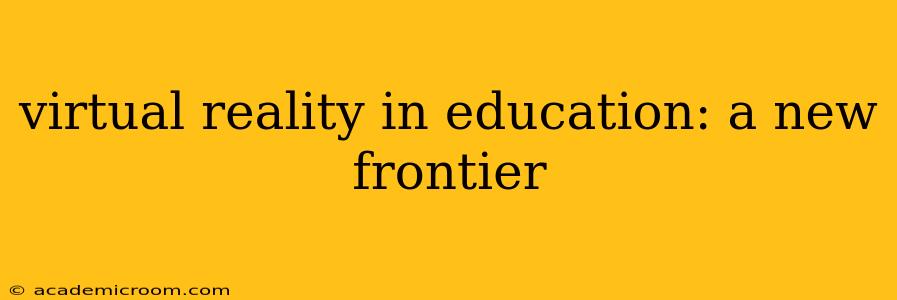Virtual Reality (VR) is rapidly transforming numerous sectors, and education is no exception. This immersive technology offers unparalleled opportunities to enhance learning experiences, making education more engaging, accessible, and effective. From simulating historical events to exploring the human body, VR's potential in the classroom is vast and exciting. This article delves into the transformative power of VR in education, exploring its benefits, challenges, and the future it holds.
What are the benefits of using VR in education?
VR offers a multitude of benefits for educators and students alike. Its immersive nature fosters deeper engagement and understanding compared to traditional methods. Students can actively participate in learning, rather than passively absorbing information. This active learning approach leads to improved knowledge retention and a more profound grasp of complex concepts. Furthermore, VR can create safe and controlled environments for students to practice skills and explore scenarios that would be impossible or impractical in a traditional classroom setting. Imagine dissecting a frog without the need for a physical specimen, or exploring the Amazon rainforest without leaving the classroom. The possibilities are endless.
What are the challenges of implementing VR in education?
Despite its immense potential, integrating VR into education presents several challenges. The most significant hurdle is the cost. High-quality VR headsets and software can be expensive, posing a barrier for schools with limited budgets. Furthermore, adequate teacher training is crucial. Educators need to be proficient in using VR technology and integrating it effectively into their lesson plans. Technical issues, such as hardware malfunctions and software glitches, can also disrupt learning. Finally, ensuring equitable access for all students is paramount; we must avoid exacerbating existing digital divides.
How can VR improve student engagement and learning outcomes?
VR's immersive nature significantly enhances student engagement. By placing students directly within the learning environment, VR captures their attention and motivates them to actively participate. This active participation translates to improved learning outcomes. Studies have shown that VR-based learning can lead to better knowledge retention and a deeper understanding of complex concepts. For instance, students learning about the human body can explore interactive 3D models, manipulating organs and observing their functions in a way that is simply not possible with textbooks or diagrams.
What are some examples of VR applications in education?
The applications of VR in education are diverse and rapidly expanding. Here are a few examples:
- Virtual Field Trips: Students can explore historical sites, natural wonders, or even other planets without leaving the classroom.
- Interactive Simulations: Students can practice skills in safe and controlled environments, such as performing surgery or managing a business.
- Gamified Learning: VR can transform learning into engaging games, making education more fun and motivating.
- Accessibility: VR can provide personalized learning experiences for students with disabilities, offering tailored support and overcoming physical barriers.
Is VR in education worth the investment?
The question of whether VR in education is worth the investment is complex and depends on various factors, including budget, available resources, and educational goals. While the initial investment can be substantial, the potential long-term benefits – improved student engagement, enhanced learning outcomes, and increased accessibility – make it a compelling option for institutions committed to innovation and educational excellence. The cost-benefit analysis needs to be carefully considered, taking into account factors like improved learning outcomes, reduced need for physical resources, and potential long-term cost savings.
What are the future trends in VR education?
The future of VR in education is bright. We can expect to see continued advancements in VR technology, leading to more immersive, affordable, and accessible experiences. The development of more sophisticated VR applications tailored to specific subjects and learning styles will further enhance the educational impact. Furthermore, integration with other emerging technologies, such as Artificial Intelligence (AI) and Augmented Reality (AR), will create even more powerful and personalized learning environments.
Conclusion
Virtual Reality is poised to revolutionize education. While challenges remain, the potential benefits – enhanced engagement, improved learning outcomes, and increased accessibility – are substantial. By addressing the challenges proactively and embracing the opportunities strategically, educators can harness the power of VR to create more effective and engaging learning experiences for students of all backgrounds and abilities. The future of learning is immersive, and the journey has only just begun.
